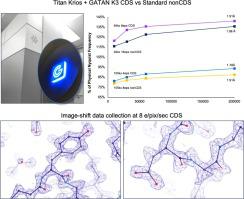Journal of Structural Biology ( IF 3 ) Pub Date : 2021-05-11 , DOI: 10.1016/j.jsb.2021.107745 Ming Sun 1 , Caleigh M Azumaya 1 , Eric Tse 2 , David P Bulkley 1 , Matthew B Harrington 1 , Glenn Gilbert 1 , Adam Frost 3 , Daniel Southworth 2 , Kliment A Verba 4 , Yifan Cheng 5 , David A Agard 1

|
Detector technology plays a pivotal role in high-resolution and high-throughput cryo-EM structure determination. Compared with the first-generation, single-electron counting direct detection camera (Gatan K2), the latest K3 camera is faster, larger, and now offers a correlated-double sampling mode (CDS). Importantly this results in a higher DQE and improved throughput compared to its predecessor. In this study, we focused on optimizing camera data collection parameters for daily use within a cryo-EM facility and explored the balance between throughput and resolution. In total, eight data sets of murine heavy-chain apoferritin were collected at different dose rates and magnifications, using 9-hole image shift data collection strategies. The performance of the camera was characterized by the quality of the resultant 3D reconstructions. Our results demonstrated that the Gatan K3 operating in CDS mode outperformed standard (nonCDS) mode in terms of reconstruction resolution in all tested conditions with 8 electrons per pixel per second being the optimal dose rate. At low magnification (64kx) we were able to achieve reconstruction resolutions of 149% of the physical Nyquist limit (1.8 Å with a 1.346 Å physical pixel size). Low magnification allows more particles to be collected per image, aiding analysis of heterogeneous samples requiring large data sets. At moderate magnification (105kx, 0.834 Å physical pixel size) we achieved a resolution of 1.65 Å within 8-h of data collection, a condition optimal for achieving high-resolution on well behaved samples. Our results also show that for an optimal sample like apoferritin, one can achieve better than 2.5 Å resolution with 5 min of data collection. Together, our studies validate the most efficient ways of imaging protein complexes using the K3 direct detector and will greatly benefit the cryo-EM community.
中文翻译:

在 CDS 模式下使用 K3 相机进行高分辨率和高通量单粒子冷冻电镜的实际考虑
检测器技术在高分辨率和高通量冷冻电镜结构测定中发挥着关键作用。与第一代单电子计数直接检测相机 (Gatan K2) 相比,最新的 K3 相机更快、更大,并且现在提供相关双采样模式 (CDS)。重要的是,与其前身相比,这会导致更高的 DQE 和更高的吞吐量。在这项研究中,我们专注于优化低温 EM 设施中日常使用的相机数据收集参数,并探索吞吐量和分辨率之间的平衡。总共使用 9 孔图像移位数据收集策略,以不同的剂量率和放大倍数收集了 8 个鼠重链去铁铁蛋白数据集。相机的性能以生成的 3D 重建的质量为特征。我们的结果表明,在所有测试条件下,在 CDS 模式下运行的 Gatan K3 在重建分辨率方面优于标准(非 CDS)模式,其中每像素每秒 8 个电子是最佳剂量率。在低放大倍率(64kx)下,我们能够实现物理奈奎斯特极限的 149% 的重建分辨率(1.8 Å,物理像素大小为 1.346 Å)。低放大倍率允许每张图像收集更多颗粒,有助于分析需要大量数据集的异质样品。在中等放大倍率(105kx,0.834 Å 物理像素大小)下,我们在数据收集的 8 小时内实现了 1.65 Å 的分辨率,这是在表现良好的样品上实现高分辨率的最佳条件。我们的结果还表明,对于像脱铁铁蛋白这样的最佳样品,可以达到优于 2 的效果。5 Å 分辨率,5 分钟数据收集。总之,我们的研究验证了使用 K3 直接检测器成像蛋白质复合物的最有效方法,并将极大地造福冷冻电镜社区。


























 京公网安备 11010802027423号
京公网安备 11010802027423号